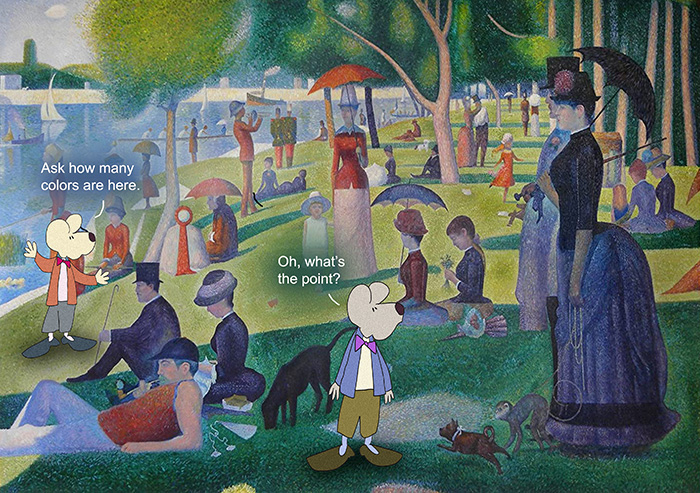I will never forget the moment when I first saw the iconic painting by Georges Seurat. I stood there, in the galleries of The Art Institute of Chicago, my first time visiting one of the major art museums in this country.
Let me back up a moment. A lot of moments, actually, back to my seventh year, or so, at Christmas. One of my presents was a board game called “Masterpiece.” I don’t remember the logistics of how it was played, but each person had several masterpiece paintings in their hands. On the front of the glossy index-sized card was the painting. Seurat, Van Gogh, Monet, Manet, Picasso, Degas, and more. Then on the back was all the information about the piece — the artist, date, location, museum, etc.
Oh, how I loved that game. I’d frequently try to talk my older siblings into playing. Anyway, those paintings stuck with me. Van Gogh’s Starry Night. Monet’s Lillies. And then there was Seurat’s “Sunday Afternoon on the Island of La Grande Jatte.”
He is one of my favorite painters, hailing from Paris, France, like so many other painters of that era. He was born December 2, 1859, and he died on this date, March 29, 1891. He was only 31 years old.
He is famous for devising the Pointillist method of painting. He also developed the technique called Chromoluminarism.
There were two sides to this guy in the way of his artistic personality. Kind of like the left brain, right brain, thing. If there is such a thing. One might typically view them as incompatible. On the one hand, he had an extreme and delicate sensibility. Creativity. On the other side of things, there was a great passion for logical abstraction. His mind worked almost to the point of mathematical precision.
“A Sunday Afternoon on the Island of La Grande Jatte” is large, large. It is 6′ 10″ high x 10′ 1″ wide. And all this space is filled with tiny colored dots. You don’t really notice this, but then, you notice this.
A little about George. He started studying art when he was about 18 years old, as far as I can tell. He worked on many different facets of art training, including sculpting and painting. For more than two years, he worked at mastering the art of monochrome drawing. Seeing a world of color in blacks and whites. That is commitment.
In summer 1884, Seurat began work on “A Sunday Afternoon on the Island of La Grande Jatte.” The painting is active, to say the least. It shows members of each of the social classes participating in various park activities. They picnic. They row. They take the pet monkey out for a walk. I kid you not.
On a canvas that large, it is really something to see all those tiny juxtaposed dots of all sorts of colors, forming image after image. It allows the viewer’s eye to blend colors optically. This was quite different than most other paintings, especially of that time, which blended the colors physically on the canvas.
George was dedicated. It took him two years to complete this monster painting. He spent a great deal of that time in the park sketching in preparation for the work. He completed around 60 studies for this work, including an actual mini-version.
I love this painting and so many others.
And with that, here is a list of the ten most famous paintings of all time (Atlantic).
1. The Mona Lisa — Leonardo da Vinci
2. Starry Night — Vincent van Gogh
3. The Scream — Edvard Munch
4. Guernica — Pablo Picasso
5. The Persistence of Memory — Salvador Dali
6. The Last Supper — Leonardo da Vinci
7. A Sunday Afternoon on the Island of La Grande Jatte — Georges Seurat
8. Girl with a Pearl Earring — Johannes Vermeer
9. Whistler’s Mother — James McNeill
10. The Birth of Venus — Sandro Botticelli
And, if you are wondering why so many of those famous artists were always getting arrested? It’s because they kept getting framed.
==========
“The most beautiful experience we can have is the mysterious. It is the fundamental emotion that stands at the cradle of true art and true science.”
― Albert Einstein, The World As I See It
==========
“Art is not what you see, but what you make others see.”
― Edgar Degas
==========
“Every child is an artist. The problem is how to remain an artist once he grows up.”
― Pablo Picasso
===========
A walk in the park with lotsa dots
